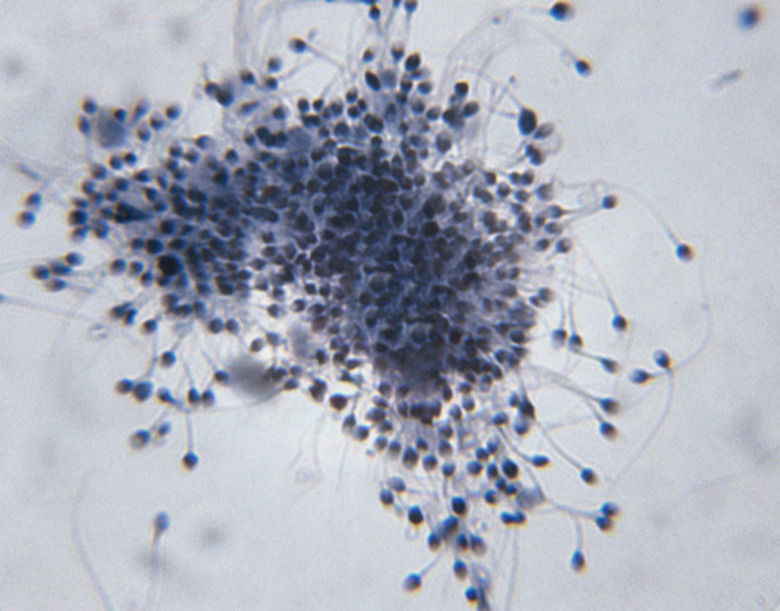What Is The Difference Between Gametogenesis In Female Mammals And Male Mammals?
In species with two separate sexes, the sex that produces the smaller and more motile sex cell or gamete is called the male. Male mammals produce gametes called sperm while female mammals produce gametes called eggs. Gametes are produced by the process of gametogenesis, and it differs markedly between males and females.
Male Spermatogenesis
Male Spermatogenesis
Sperm formation takes place in the seminiferous tubules of the testes. Here a spermatogonial stem cell divides by mitosis. This first division is asymmetric, meaning that one daughter cell becomes a stem cell while the other adopts different characteristics. This second daughter cell, the spermatogonium, in turn divides by mitosis to yield a primary spermatocyte, which now divides by meiosis.
The first phase of meiosis gives rise to two secondary spermatocytes; during the second phase, each secondary spermatocyte will divide into two spermatids. These spermatids do not undergo any further divisions but continue to differentiate to become sperm cells. The whole process of division and differentiation begins in the outer part of the seminiferous tubule and ends toward the center. In other words, the spermatogonia are located close to the edge of the tubule whereas the spermatids and sperm are located at the center.
Female Oogenesis
Female Oogenesis
Gametogenesis in female organisms is knows as oogenesis, the process that gives rise to eggs. It takes place in the ovary, where primordial germ cells divide by mitosis to yield oogonia. These in turn divide to yield primary oocytes. The primary oocytes begin phase I of meiosis but do not complete it–they are arrested partway, and in most female mammals at birth the female fetus already has her full complement of primary oocytes. Each primary oocyte is enclosed within a small aggregation of cells called an ovarian follicle.
Following puberty, hormonal cycles periodically cause some of the follicles to begin growing again; generally, only one will actually mature at a time, however, and during this process the primary oocyte will resume the first phase of meiosis, dividing to yield a secondary oocyte and a cell called a polar body, which is discarded and eventually degenerates. Meanwhile, the secondary oocyte begins the second phase of meiosis but does not complete it–it halts here and is released through ovulation. Only once it is penetrated by the sperm does the egg complete the second phase of meiosis, forming another polar body that degenerates.
Key Differences
Key Differences
As you can see, when you compare and contrast spermatogenesis and oogenesis, there are numerous differences between the two processes. Sperm lack many of the materials most cells need to sustain growth; they have a nucleus carrying DNA and large numbers of mitochondria but very little compared to the egg, which has a full complement of organelles and a store of substrates and enzymes. The egg is also much larger than the sperm and much less motile. Unlike spermatogenesis, which takes place more or less continually following puberty, oogenesis only takes place at certain times (on a monthly basis in humans, for example).
Other Differences
Other Differences
Oogenesis produces polar bodies, cells that are discarded during meiotic divisions; during spermatogenesis, by contrast, no such polar bodies are formed. Consequently, a single primary oocyte gives rise to only one egg and three polar bodies whereas a single primary spermatocyte can give rise to four sperm. Moreover, the number of eggs a female can produce is limited in most species of mammals by the number of available primary oocytes whereas the number of sperm a male can produce is not limited in the same way.
References
- "Biology"; Neil A. Campbell, Jane B. Reece, Lisa A. Urry, Michael L. Cain, Peter V. Minorsky, Steven A. Wasserman, Robert B. Jackson; 2008
- NCBI Bookshelf: Oogenic Meiosis
Cite This Article
MLA
Brennan, John. "What Is The Difference Between Gametogenesis In Female Mammals And Male Mammals?" sciencing.com, https://www.sciencing.com/difference-female-mammals-male-mammals-8092368/. 6 August 2018.
APA
Brennan, John. (2018, August 6). What Is The Difference Between Gametogenesis In Female Mammals And Male Mammals?. sciencing.com. Retrieved from https://www.sciencing.com/difference-female-mammals-male-mammals-8092368/
Chicago
Brennan, John. What Is The Difference Between Gametogenesis In Female Mammals And Male Mammals? last modified March 24, 2022. https://www.sciencing.com/difference-female-mammals-male-mammals-8092368/
